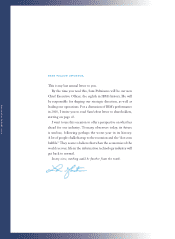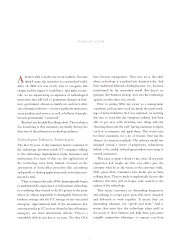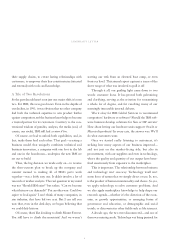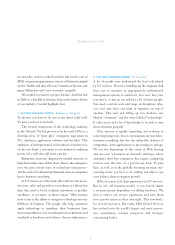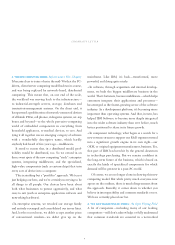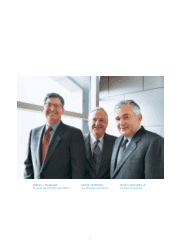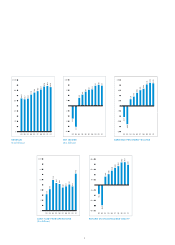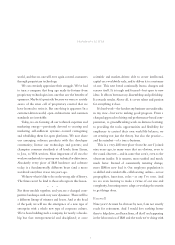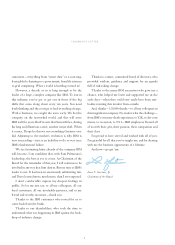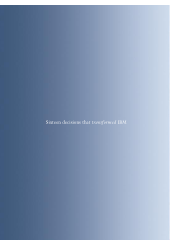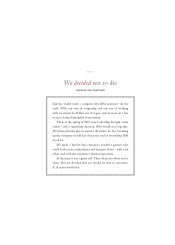IBM 2001 Annual Report Download - page 3
Download and view the complete annual report
Please find page 3 of the 2001 IBM annual report below. You can navigate through the pages in the report by either clicking on the pages listed below, or by using the keyword search tool below to find specific information within the annual report.1
Amassive shift is under way in our industry. You may
think I mean the transition to a networked world.
After all, IBM was one of the first to recognize this
change and the impact it would have. And make no mis-
take, we are experiencing an explosion of technological
innovation that will lead to permanent changes in busi-
ness, government, education, health care and every other
area of human endeavor
—
as every significant institution,
every product and service, as well as billions of people,
become permanently “connected.”
But that’s not the shift I’m talking about. The revolution
I’m describing is that customers are finally driving the
direction of the information technology industry.
Technologists Talking to Technologists
The first 30 years of this industry’s history consisted of
the technology inventors inside I/T companies talking
to the technology implementers inside businesses and
institutions. For most of that era, the applications of
the technology were fairly limited
—
focused on the
automation of back-office processes like accounting
and payroll, or desktop applications such as word process-
ing and e-mail.
Then, starting in the early 1990s, businesspeople began
to understand the importance of information technology
to everything they wanted to do. It’s gotten to the point
where it’s almost impossible to distinguish between the
business strategy and the I/T strategy of any successful
enterprise. Approximately half of the investments that
customers make in I/T are now driven by line-of-business
managers, not chief information officers. This is a
remarkable shift in just five or six years. Not that CIOs
have become unimportant. They now sit at the table
where technology is translated into business value. And
their traditional bailiwick of infrastructure, too, has been
transformed by the networked world. But there’s no
question that business strategy now sets the technology
agenda, not the other way around.
Prior to joining IBM, my career as a management
consultant and executive took me inside the inner work-
ings of many industries. So I was surprised, on entering
this one, to learn that the computer industry had been
able to get away with inventing new things and just
“throwing them over the wall,” leaving customers to figure
out how to integrate and apply them. That wasn’t easy
for those customers, for a lot of reasons. One was the
absence of common standards. The industry model was
designed around a variety of proprietary architectures
(which, to be candid, technology providers were using to
control customers).
This came as quite a shock to me, since all my prior
experience had taught me that you either give the
customer what he or she wants, or the customer walks.
Well, guess what? Customers have finally put on their
walking shoes. They’ve made it emphatically clear to this
industry that they will no longer cede control to the
makers of the technology.
That means customers are demanding integration,
and refusing to accept piece parts that aren’t designed
and delivered to work together. It means they are
demanding solutions, not “speeds and feeds.” And it
means they insist that the technology adapt itself to
the needs of their business and help them gain some
tangible competitive advantage
—
to squeeze cost from
chairman’s letter

